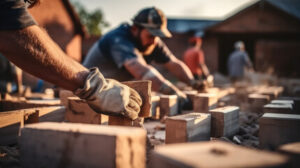Steel Commercial Buildings OKC require little maintenance and are resistant to rot, mold, and termite infestation. Their sturdy construction also enables them to withstand severe weather conditions like high winds and heavy snow loads.

They are erectable in less time than traditional building materials, which translates to decreased construction costs and faster occupancy. They are also designed with wide-span floors, allowing open spaces that do not have to be configured around support columns.
Steel is a versatile building material that has numerous applications in construction. It can be used for many different types of buildings and structures, from a warehouse to an office. Its versatility means it is a good choice for any type of business, regardless of industry or size. There are several benefits of a metal commercial building, including its ability to withstand harsh weather conditions and the lack of need for frequent repairs and maintenance.
Metal buildings can be designed to meet specific requirements and can easily accommodate modifications or expansions. This is an advantage for any business, as it enables you to grow your company at its own pace and adapt the building to meet changing needs. In addition, steel buildings are energy efficient and can retain heat better than traditional buildings.
Warehouses are a common use for a metal commercial building, as they offer plenty of space and a durable environment for storing products. They are also easy to customize, and can include features such as shipping and receiving doors, ventilation, skylights, and insulation. They can also be built with clear span framing, which allows for large interior spaces and makes it easier to move around oversized equipment.
Industrial steel buildings are a popular choice for commercial spaces, as they can be constructed quickly and are suitable for a variety of uses. They are also extremely durable and can withstand harsh weather conditions, such as powerful winds and heavy snow loads. Additionally, they are more resistant to fire and seismic activity than other buildings, which makes them a great choice for businesses that require a safe working environment.
Residential buildings made of steel are becoming increasingly popular, as they are more affordable than other building materials and can be designed to look like a traditional house or have a modern, industrial appearance. They are also energy efficient and require less maintenance than other buildings, and they can withstand natural disasters, such as hurricanes and tornadoes. Additionally, they are resistant to pests and mold, which makes them a good choice for homeowners who want a safe and secure home.
Durability
Steel buildings are incredibly durable and long-lasting, withstanding harsh weather conditions that shorten the lifespan of other types of structures. They are resistant to mold, mildew, pests, and water damage that can quickly become a costly issue for other types of structures, saving money on maintenance costs over the lifetime of the building. Additionally, their resistance to fire helps to keep people safe and reduce the cost of insurance.
Because they can easily be altered to suit changing needs, steel commercial buildings are ideal for a variety of uses. For instance, their strength makes them a good choice for warehouses or distribution centers, which require large, open spaces and heavy-duty infrastructure. The flexibility of a steel building also means that it can be designed with high ceilings and wide door openings to accommodate larger inventory items, as well as specialized layouts to facilitate a smooth workflow.
The durability of steel buildings also makes them suitable for manufacturing facilities, which often use large machinery and complex processes that must be properly ventilated to prevent heat build-up or hazardous fumes. The flexibility of a steel structure allows it to be designed with multiple openings and venting systems, making it easier to accommodate changing production demands. In addition, the inherent fire resistance of steel can help protect employees and inventory.
Another important factor in determining how long a building will last is its tensile strength, which determines how much pressure a structure can withstand before it starts to crack or break. Steel structures have an excellent tensile strength, meaning that they are able to withstand jolting from powerful winds or seismic forces.
Durability is also an important factor when it comes to choosing the location of a building, as local climate patterns can impact how well a structure will hold up over time. For example, areas that receive heavy snowfall will likely need more frequent maintenance and repairs than other locations. Additionally, seaside environments may wear down buildings faster due to the salt and humidity in the air.
In addition to these factors, the durability of a steel building is determined by its ability to resist pests. Steel is non-porous and does not attract pests like termites, which can wreak havoc on the structural integrity of a building. This also makes it a safer option for storing valuables or equipment, as pests cannot get inside the walls of a metal building.
Ease of Construction
Steel commercial buildings can be designed and built to accommodate a wide variety of floor plans. They also can be enlarged as business needs change. Unlike buildings made of other materials, there are no length restraints for steel structures. This allows the use of large open spaces which are particularly desirable for sports facilities. In addition, the strength of steel offers longer on-center spacing possibilities and larger clear span capabilities than any other building material.
The construction process for a steel building is relatively fast, especially when compared to traditional methods of constructing a similar structure. This is because the components are pre-engineered, meaning they are fabricated and assembled before being delivered to the project site. Depending on the size of the structure, the erection process can be completed in about 3-6 days. It is important to remember that the construction of a steel building can only proceed once local building inspectors approve it for occupancy.
A key to ensuring a smooth construction process is choosing the right manufacturer of prefabricated metal buildings from the start. The best manufacturers will have a team of engineering professionals who can walk you through design choices, permitting, and installation preparations, as well as supply blueprints for the local inspectors to review.
When the steel building components arrive on the job site, they will be carefully packaged and labelled, allowing the crew to quickly locate and cross-reference the parts against the blueprints and erection manuals once construction begins. Because there is little welding involved, and most of the major parts are a perfect fit with each other, assembling a metal building is typically easy and requires very few tools.
Once the building skeleton is erected, the roof and wall sheeting can be added. Then, doors and windows can be installed and finished. Finally, any special industrial equipment can be added to the structure, such as overhead cranes and skylights.
Once the final touches are put on, your steel commercial building is ready to serve you and your customers. It will have a modern, clean look that you simply cannot achieve with other types of construction.
Affordable
In addition to being more affordable than traditional building materials, steel buildings are also easier and faster to construct. This helps save money on labor costs and can shorten the construction timeline for your business. Additionally, steel buildings are highly energy efficient and can help you save on heating and cooling costs over time. This can significantly reduce your commercial energy bills.
Another way that a steel building can save you money is through its durability. Because they’re able to withstand extreme weather conditions, they’ll last for many years to come. This means that you won’t need to worry about costly repairs or replacements. Moreover, they can also be refurbished easily to extend their lifespan even further.
A steel commercial building is also a great choice for offices, as they can be easily customized to suit the needs of any company. For example, you can add partitions to create a more spacious office space or choose from a variety of window types and sizes. Additionally, you can opt for skylights or insulation to make the space more comfortable and energy efficient.
Steel buildings are a perfect solution for warehouses, as they can be erected quickly and are designed to have large open floor plans. They’re also a great option for self-storage facilities, as they can be used to store items on a long-term basis.
When it comes to the cost of a steel commercial building, it will vary depending on your specifications and the features you choose. However, a basic steel building will start at about $12-25 per square foot. This includes the foundation, steel frame, roof, and walls. You can also add on other elements, such as windows, doors, and insulation, to further customize the building.
The most important thing to keep in mind is that the cost of a steel commercial building can go up with every customization you add. Try to limit your design customizations to only the most impactful components, as this will help keep the costs down. In addition, consider purchasing all your building materials at once to take advantage of bulk discounts.
